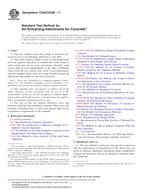1.1 This guide describes procedures for obtaining data concerning the adverse effects of an effluent or a test material (added to dilution water, but not to food) on Ceriodaphnia dubiaRichard 1894, during continuous exposure throughout a portion of the organism’s life. These procedures should also be useful for conducting life cycle toxicity tests with other Cladocera (Guide E 1193), although modifications will be necessary.
1.2 These procedures are applicable to most chemicals, either individually or in formulations, commercial products, or known mixtures, that can be measured accurately at the necessary concentrations in water. With appropriate modifications these procedures can be used to conduct tests on temperature, dissolved oxygen, pH, and on such materials as aqueous effluents (see also Guide E 1192), leachates, oils, particulate matter, sediments (see also Guide E 1383), and surface waters. Renewal tests might not be applicable to materials that have high oxygen demand, are highly volatile, are rapidly biologically or chemically transformed, or sorb to test chambers. If the concentration of dissolved oxygen falls below 4 mg/L or the concentration of test material decreases by more than 20 % in test solution(s) between renewals, more frequent renewals might be necessary.
1.3 Other modifications of these procedures might be justified by special needs or circumstances. Results of tests conducted using unusual procedures are not likely to be comparable to results of many other tests. Comparisons of results obtained using modified and unmodified versions of these procedures might provide useful information on new concepts and procedures for conducting three-brood toxicity tests with C. dubia.
1.4 This standard does not purport to address all of the safety concerns, if any, associated with its use. It is the responsibility of the user of this standard to establish appropriate safety and health practices and determine the applicability of regulatory limitations prior to use. Specific hazard statements are given in Section 8.
1.4 This guide is arranged as follows:
| Section | |
| Referenced Documents | 2 |
| Terminology | 3 |
| Summary of Guide | 4 |
| Significance and Use | 5 |
| Apparatus | 6 |
| Facilities | 6.1 |
| Construction Materials | 6.2 |
| Test Chambers | 6.3 |
| Cleaning | 6.4 |
| Reagents and Materials | 7 |
| Hazards | 8 |
| Dilution Water | 9 |
| Requirements | 9.1 |
| Source | 9.2 |
| Treatment | 9.3 |
| Characterization | 9.4 |
| Test Material | 10 |
| General | 10.1 |
| Stock Solution | 10.2 |
| Effluent | 10.3 |
| Test Concentration(s) | 10.4 |
| Collection | 10.5 |
| Sample Containers | 10.6 |
| Preservation | 10.7 |
| Treatment | 10.8 |
| Test Organisms | 11 |
| Species | 11.1 |
| Age | 11.2 |
| Source | 11.3 |
| Brood Stock | 11.4 |
| Food | 11.5 |
| Handling | 11.6 |
| Quality | 11.7 |
| Procedure | 12 |
| Demonstration of Feasibility | 12.1 |
| Experimental Design | 12.2 |
| Dissolved Oxygen | 12.3 |
| Temperature | 12.4 |
| Preparing Test Solutions | 12.5 |
| Conditioning Test Chambers | 12.6 |
| Beginning a Test | 12.7 |
| Renewing Test Solutions | 12.8 |
| Duration of Test | 12.9 |
| Biological Data | 12.10 |
| Other Measurements | 12.11 |
| Analytical Methodology | 13 |
| Acceptability of Test | 14 |
| Calculation | 15 |
| Report | 16 |
| Appendixes | |
| Food | X1 |
| Culture Techniques | X2 |
| Test Chambers | X3 |
| Statistical Guidance | X4 |
Product Details
- Published:
- 01/01/1995
- Number of Pages:
- 20
- File Size:
- 1 file , 120 KB


